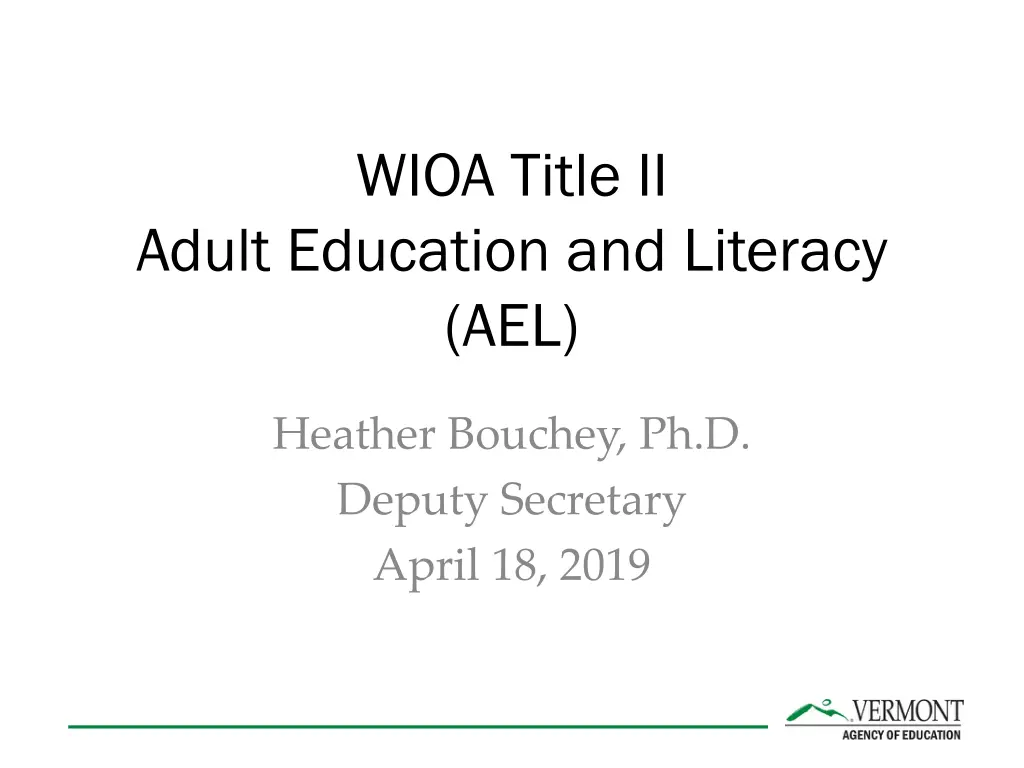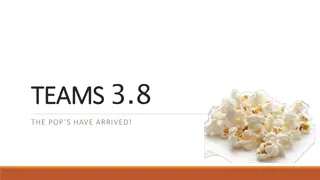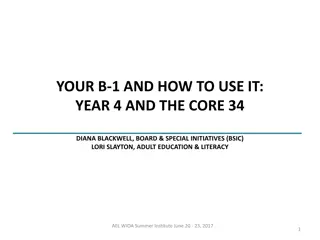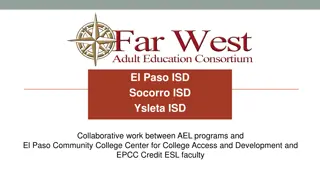
Adult Education and Literacy in Vermont
Learn about Adult Education and Literacy (AEL) services in Vermont, providing essential educational, workforce training, and transitional services to adults. Discover eligibility criteria, required services, providers, and the significant impact of AEL on Vermonters.
Download Presentation

Please find below an Image/Link to download the presentation.
The content on the website is provided AS IS for your information and personal use only. It may not be sold, licensed, or shared on other websites without obtaining consent from the author. If you encounter any issues during the download, it is possible that the publisher has removed the file from their server.
You are allowed to download the files provided on this website for personal or commercial use, subject to the condition that they are used lawfully. All files are the property of their respective owners.
The content on the website is provided AS IS for your information and personal use only. It may not be sold, licensed, or shared on other websites without obtaining consent from the author.
E N D
Presentation Transcript
WIOA Title II Adult Education and Literacy (AEL) Heather Bouchey, Ph.D. Deputy Secretary April 18, 2019
What is AEL? What is AEL? System offering essential educational, workforce training, postsecondary, and employment transitional services to the adult population. Students work with trained professionals to: earn credentials, meet college and career goals, learn new job skills to transition to new employment, and work to improve outcomes for themselves and their families. Long history of personalization in Vermont
Required services Required services Adult education and literacy English language acquisition Integrated English Literacy and Civics Education (IEL/CE) Workforce preparation activities Integrated education and training (IET)
The Tutorial Center Where is AEL? Where is AEL? There are four providers and 17+ local learning centers that provide adult education and literacy services in Vermont. Vermont Adult Learning
Who is Eligible? Who is Eligible? Eligible individual means an individual: who has attained 16 years of age; who is not enrolled or required to be enrolled in secondary school under State law; and who is basic skills deficient; does not have a secondary school diploma or its recognized equivalent, and has not achieved an equivalent level of education; or is an English language learner.
Who does Who does VT AEL serve? VT AEL serve? 2,511 adults; M=1,060, F=1,451 >60% aged 16-24 610 parents (24.3%) 445 on public assistance (18%)* 1,496 unemployed or not in labor force 59% have basic skills (8thgrade level or below) 77% lack a high school diploma 59% have a disability* 17% are English Language Learners *reported (FY18 data)
The Need in Vermont Adult Vermonters with less than a high school education*: 33,883 ages 25 and older (of these, 33% completed less than 9thgrade) 6,480 ages 18-24 Total: 40,363 AEL served 1,846 Vermonters aged 18+ in calendar year 2017 (or approximately 4.6% of those who needed services) *Source: American FactFinder s estimates for 2017 (most recent data available)
Funding Funding for for VT AEL VT AEL Approximately 19% of funds awarded to AEL Providers is Federal and 81% is State. AEL Providers contribute 15% cash/in-kind match to State funds. There has been a modest increase in AEL Federal funds allocated for FY19 (for Vermont: 6% or $52,392) and there is a modest anticipated increase for FY20
Five Types of Measurable Skill Gains for WIOA Measurable Skill Gains Used in Title II Passing technical/ occupational knowledge-based exam Secondary diploma/ equivalent Secondary or postsecondary transcript Educational functioning level gain Progress toward milestones Program exit + entry into postsecondary education Completion of Carnegie Units Pre-post test
Five Types of Measurable Skill Gains for WIOA Measurable Skill Gains Used in Title II Secondary diploma/ equivalent Educational functioning level gain Program exit + entry into postsecondary education Pre-post test
Federal EFL/MSGs Reported 50.00% 45.00% 40.00% 35.00% 30.00% 25.00% 20.00% 15.00% 10.00% 5.00% 0.00% FY15 FY16 FY17 FY18 CVABE 33.15% 25.47% 44.87% 44.15% NEKLS 23.81% 23.79% 45.30% 30.95% TTC 18.98% 29.46% 33.33% 39.62% VAL 21.78% 26.21% 27.26% 37.52% State 24.12% 26.04% 28.59% 38.07% CVABE NEKLS TTC VAL State
Employment Performance Indicators Second Quarter Employment The percentage of participantswho are in unsubsidized employment during the second quarter after exit Fourth Quarter Employment The percentage of participantswho are in unsubsidized employment during the fourth quarter after exit
Employment Performance Indicators (cont.) Second quarter after exit Median earnings of participants who are in unsubsidized employment during the second quarter after exit from the program Median Earnings
Credential Attainment Indicator Secondary Credential Postsecondary Credential Percentage of participants who obtain a secondary school diploma or equivalent while enrolled or within one year of exit and who are employed or enrolled in a postsecondary education or training within one year of exit Percentage of participants who obtain a recognized postsecondary credential while enrolled or within one year of exit
AEL Grant Cycle and Competition Under WIOA, AEL grant funding must be competed. Per Vermont s State Plan, AEL funds are competed every three years. The last RFP was issued in February 2017 for FY18-FY20 awards. The next RFP will be issued in early 2020.
Rules for Review 463.21 What processes must be in place to determine the extent to which a local application for grants or contracts to provide adult education and literacy services is aligned with a local plan under section 108 of WIOA? (a) An eligible agency must establish, within its grant or contract competition, a process that provides for the submission of all applications for funds under AEFLA to the appropriate Local Boards. (b) The process must include-- (1) Submission of the applications to the appropriate Local Board for its review for consistency with the local plan within the appropriate timeframe; and (2) An opportunity for the local board to make recommendations to the eligible agency to promote alignment with the local plan. (c) The eligible agency [AOE] must consider the results of the review by the Local Board in determining the extent to which the application addresses the required considerations in 463.20.
13 Award Considerations AOE Reviews 1.Responsiveness to regional needs 2. Serving individuals with disabilities 3. Past effectiveness 4. Alignment with One-Stop Partners 5. Intensity and quality of program 6. Evidence-based instructional practices 7. Effective use of technology 8. Facilitated learning in context 9. Qualified instructors and staff 10. Partnerships and support services for development of career pathways 11. Flexible scheduling 12. High-quality data collection and management 13. Integrated English literacy and Civics Education
Two sections that SWDB will review and score 1. Responsiveness to regional needs 4. Alignment with one-stop partners
The score ratings of the SWDB are specific to how it sees the application aligning with the State Plan. Other comments are welcome (though not required) to: Help the AOE give feedback to the grant applicants Provide information that can help in developing the grant agreements with each individual grantee.
Draft Timeline FY21-23 Funding Competition January 12, 2020 Funding opportunity and grant application released February 5 Intent to Apply Form due By February 14 Applicant Workshop March 4 Proposals due By March 10 orientation for SWDB reviewers held March 25 SWDB reviewers complete review April 17 awards announced July 1 grant period begins
Questions? Robin.Castle@Vermont.gov (802) 479-1279 State Director of Adult Education and Literacy Vermont Agency of Education






















